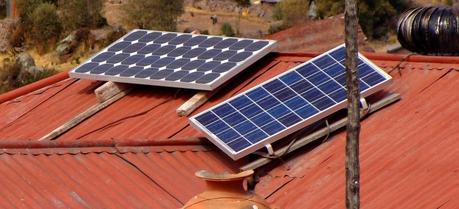 Residents of Taquile Island (island on the Peruvian side of Lake Titicaca 45 km offshore from the city of Puno ) widely use solar panel-generated electricity. (Credit: Flickr @ Julia Manzerova http://www.flickr.com/photos/julia_manzerova/)
Residents of Taquile Island (island on the Peruvian side of Lake Titicaca 45 km offshore from the city of Puno ) widely use solar panel-generated electricity. (Credit: Flickr @ Julia Manzerova http://www.flickr.com/photos/julia_manzerova/)Peru may be best known for Machu Pichu and other Incan and Aztec treasures, but the nation is looking to its future with new plans to use solar to provide electricity for about 2 million of it poorest residents by the end of 2016. Considering that Peru is the third largest county in South America and has a population of 24 million that’s bringing solar power to roughly 10 percent of its population.
The country, which is the world’s second largest exporter of copper, is experiencing strong demand for new electric generation to support it’s mining and other operations. As such, it needs to add 500 megawatts of new electric generation annually for the next few years. In all it plans to add in 2.1 gigawatts of new electric generation. The solar being installed will only be a part of the larger target, which include hydro-electric and gas-fired electric generating power plants. The country, according to Merino will add in 1 gigawatt of hydro-electric 800 megawatts of gas-diesel power plants and 300 megawatts of renewable energy.
When completed “The National Photovoltaic Household Electrification Program” and other programs will allow 95 percent of Peru’s population access to electricity. While that’s not everyone, it’s a pretty high percentage of the population and it’s a rapid ramp up. Right now about 66 percent of the country’s population has access to electricity in the mountain-rich country.
“This program is aimed at the poorest people, those who lack access to electric lighting and still use oil lamps, spending their own resources to pay for fuels that harm their health,” said Peru Energy and Mining Minister Jorge Merino.
Under the first phase of the program 500,000 homes will get access to power from roughly 12,500 PV arrays. For example, 1,700 household in Peru’s Cajamarca region will for the first time gain access to electricity this year with the use of domestic solar panels. The solar program is part of Peru’s larger effort to add in enough electric generation to meet its citizens’ needs. The first phase is expected to cost $200 million, which is only part of the $3 billion that Peru plans to spend on new electric generation.
By bringing access to electricity throughout so much of the country it could help propel the country’s economy and help more of its citizens get access to health services, refrigeration, water filtering and more. It can also bring more of the country’s rural areas out of poverty. After all, the United Nations Development Programme’s 2012 Human Development Index reports that about half of the country’s people are poor and 20 percent of its people are considered extremely poor.
This article was originally posted on SolarReviews by Chris Meehan.

